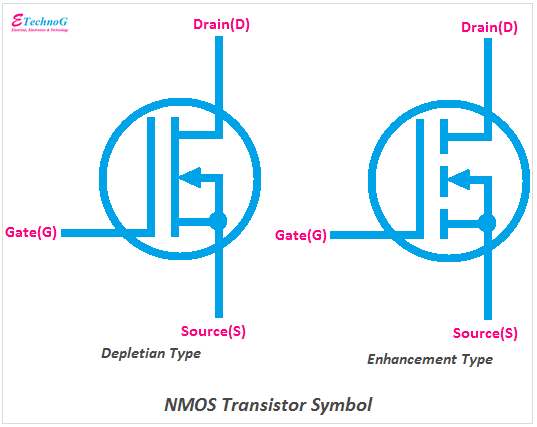Difference between NMOS, PMOS, CMOS Transistor with Symbols
The main difference between NMOS, PMOS, and CMOS transistors is that the NMOS transistor conducts current when there is a voltage across the gate, the PMOS transistor conducts current when there is no voltage across the gate, and the CMOS Transistor has dual characteristics.
MOSFET or Metal Oxide Semiconductor Field Effect Transistor is a very fast switching transistor and it is used in almost all electronic circuits, ICs, and devices. According to the construction and uses of substrates, there are mainly two types of MOSFET,
- N Chanel MOSFET or NMOS Transistor
- P Channel MOSFET or PMOS Transistor
Another newly developed MOSFET is the CMOS Transistor which is built with the combination of both N channel and P channel MOSFET. Nowadays, CMOS transistors are widely used due to their low power loss, high reliability, low noise, etc.
What is an NMOS Transistor?
N channel MOSFET to NMOS is a type of MOSFET whose source is constructed by the N-type substrate and drain is constructed by the P-type substrate. The carriers in the NMOS transistor are electrons which means the electrons are responsible for the current conduction.
In normal conditions, there is no conductive channel between the source and drain, when a voltage is applied across the gate, holes from the gate or p-type substrate start to drive away in the body and it creates an n-channel between the source and drain. Once the n-channel is created current can be conducted from the source to the drain.
So the basic concept is that when there is a minimum voltage available across the gate terminal a connection is built up between the source and drain terminal or they act as a closed circuit when there is no voltage or zero voltage across the gate terminal the connection is removed or disconnected between the source and drain terminals or they act as an open circuit.
N-channel MOSFET or NMOS also has two types - enhancement type and depletion type MOSFET. NMOS Logic or NMOS technology built the logic gates and other different types of digital circuits using NMOS transistors.
NMOS Transistor Symbol
Here, you can see the symbol of NMOS Transistor.
What is a PMOS Transistor?
The P-channel MOSFET or PMOS transistor is exactly opposite to the NMOS Transistor. The source of the PMOS transistor is constructed with a p-type substrate whereas the drain is constructed with an n-type substrate. Here, holes are the carrier in the PMOS transistor. Holes are responsible for the current conduction. When a negative voltage across the gate and source is applied, a p-type channel having opposite polarity is formed between the source and drain, so current can flow from the source to the drain.
So the basic concept is that in normal conditions when there is no voltage across the gate terminal, there is a connection available between the source and drain or they act as a closed circuit but when a voltage is applied across the gate terminal the connection between the source and drain terminals are removed and they act as an open circuit.
The logic gates, logical circuits, and other digital circuits using PMOS transistors are called PMOS Logic or PMOS technology. PMOS logic is more expensive and very difficult to build than NMOS Logic.
PMOS Transistor Symbol
Here, you can see the symbol of PMOS Transistor.
What is a CMOS Transistor?
CMOS means Complementary Metal Oxide Semiconductor. The CMOS Transistor is constructed by both NMOS and PMOS Transistors. It is basically an integrated circuit built with those two transistors. As both the transistors are used, the CMOS has both characteristics. The NMOS transistors in the CMOS create a low resistance path between the source and drain when the gate voltage is high and the PMOS transistor in the CMOS creates a low resistance path between the source and drain when the gate voltage is low.
Here, you can see the circuit diagram of CMOS constructed by a PMOS and an NMOS.
Difference between PMOS, NMOS, and CMOS Transistors
1. The carrier in the PMOS Transistor is a hole. The carrier in the NMOS transistor is an electron. The carriers in the CMOS transistor are both electrons and holes.
2. PMOS and NMOS are simple enhancement or depletion-type devices whereas the CMOS is an integrated circuit built with both PMOS and NMOS transistors.
3. PMOS and NMOS have a single characteristic whereas the CMOS transistor has dual characteristics that exist between both NMOS and PMOS.
4. CMOS has more functions, low noise, and high speed than NMOS and PMOS transistors.
Read Also:



